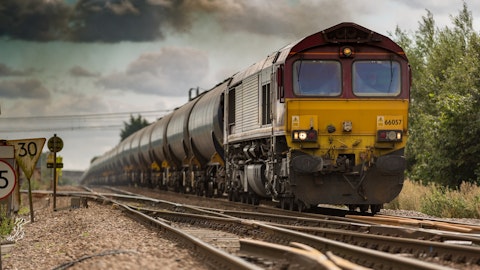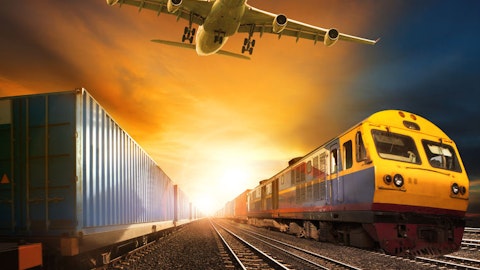Bascome Majors: Thank you all for the time.
Operator: Our next question comes from Ken Hoexter with Bank of America. Please go ahead.
Ken Hoexter: Hey, Lorie and team. Good morning. Just to clarify, Lorie, that last answer there. So if you’re, it looks like you’re getting more external orders, right? Or if I’m understanding you, right? So does that mean we get more real time revenue recognition in terms of that, that eliminating maybe some of the lumpy delivery surprises because you get that as you build more for external or is that not what you’re suggesting?
Lorie Tekorius: No, what I’m suggesting is so we have, so if you think about it, someone needs a rail car. They may want to buy it. That’s great. We’re happy to build a rail car and sell it straight out. Oftentimes, we have folks who don’t want to buy a car. They want to lease the car. We have very strong lease origination capabilities to the extent that we are building our owned lease fleet to create this recurring revenue cash flow, tax-advantaged cash flow stream, predictable revenue. We’re keeping some of those on our balance sheet, meaning over time, as we grow our portfolio, you are going to have more of this recurring revenue and stable earnings. In the short term, that means that some of the immediate satisfaction you might get through the P&L by selling the car or syndicating them, that’s going to get deferred.
Ken Hoexter: Yes, so no change. It’s not like this new order is changing that. It’s just this is the whole concept of adding the leasing just creates that more stability. I thought there was a message you were maybe getting some more orders which would have stalled some of this syndication?
Lorie Tekorius: No, yes.
Ken Hoexter: Yes, Go ahead.
Lorie Tekorius: No, I was just going to say we are keeping more of what we originate on our balance sheet than we would have historically.
Ken Hoexter: And then I just want to revisit, I guess, Justin and Bascome’s questions on the delivery to understand. I know you said you’ve got maybe 10% left and available, but yet this number being down is, Lorie, is that you being conservative in terms of that built potential? Is there a potential where you create more spaces through an intermodal potential there? I just want to understand, obviously, the stock is taking a hit today given you had this great order number a month or so ago, and now it seems like we’re constrained on that build in that fiscal ’24 outlook. I just want to understand the messaging just seems a little odd, if you can help me understand that a bit.
Lorie Tekorius: Sure, and I guess what I would say is we’re trying to highlight the fact that some of our new car production space is being consumed. I think Brian indicated about 15% of our space is being consumed by activity that does not show up in just a delivery statistic. We can think about how we do a different job to identify how much of what’s the revenue or the margin potential on that activity. But I would say that the OEMs in the North American space are being a bit more disciplined as opposed to just trying to crank the dial up to juice out a bunch of deliveries in a particular period. But we’re thinking about the longer term and when our customers need the rail cars and what’s that right steady pace of producing cars.
So as we look at our footprint and make certain that we are utilizing the investments that we’ve made in that footprint to generate return, it is not as easy as in the past where it was just look at deliveries and convert it to revenue. There’s other activity going on.
Adrian Downes: And the one thing I would add, Ken is that I mean this is part of our DNA is solving our customers problems and our customers don’t always need a new rail car. Sometimes they need a large number of cars refurbished, converted, and this is where we step in and we work with our long-term core customers and take care of it from that perspective versus just trying to jam new cars down their throat.
Ken Hoexter: Yes, that makes complete sense. So maybe there’s a new statistic. I don’t know whether you kind of give like, hey, that thousand car potential turns into X number of remods or something that that can I guess somehow fill that revenue void or understanding that future revenue potential void.
Lorie Tekorius: Great [statistics], Ken.
Ken Hoexter: Great. Yes, no. My last one, sorry, I’m just going to squeeze another one in quickly. But international, is there some discussion I know in the release you talked about what was being done now Brazil and included in the number of your outlook? Is there maybe an international versus domestic mix or in the backlog you can talk to?
Brian Comstock: I would say that our international activity is relatively stable. Our Brazil activity has been historically included in our deliveries and backlog but overall it’s about 20% of orders in the most recent quarter, about 20-ish percent I think in backlog and it is predominantly weighted towards European activity because it is much larger there and there is more just overall activity going on versus Brazil but Brazil continues to be a very profitable operation for us just on a smaller scale. And we call out Brazil separately. It is small but we account for Brazil. We don’t consolidate it so it flows through the equity method of accounting. We do include the deliveries and backlog but it doesn’t flow through our revenue line over time which is why we’ve historically called that out separately. It’s not because it’s changing that we’re calling it out this quarter.
Lorie Tekorius: And then maybe the one last thing I would jump in on when it comes to international is we are getting some nice traction in Europe on originating leases. So this is where in the European market we are taking those commercial capabilities that we have to originate at least working directly with the shipper. The difference for now is that we’re not holding those railcars on our balance sheet but we are syndicating them through to a syndication partner but it does give us more control of our production levels, our production schedule and puts us right in touch with our customer which has served us well in the North American market.
Ken Hoexter: Great thanks Lorie, Justin, Adrian and Brian appreciate the thoughts.
Adrian Downes: Thanks Ken.
Operator: Our next question comes from Allison Poliniak with Wells Fargo. Please go ahead.
Ryan Deveikis: Good morning, this is Ryan Devakas on for Allison. Just I guess asked in another way, I mean you guys used to provide some level of detail on railcar refurbishments. I think last quarter it was 1,000 railcar units at 85 million. Is there any, like, can you record, well, I guess what I’m trying to say is, can you give that level of detail now, and then, like, let’s baked into the fiscal ’24 guidance?



